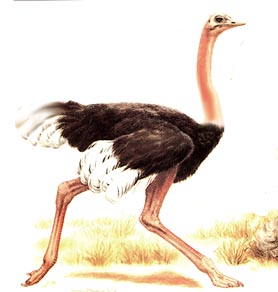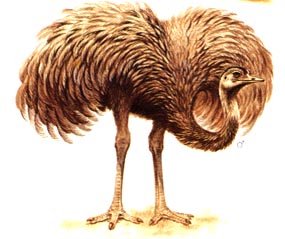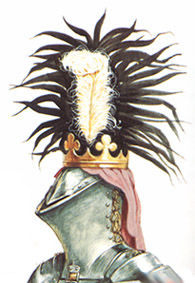

The Ostrich in Heraldry and Lore

THE OSTRICH:
The Greek word for ostrich was originally the name for the sparrow (struthus). To avoid confusion the word megas meaning "large" was added. The ostrich was known to exist in the Meditteranean regions in the fifth century B.C., in northern Africa, and Mongolian China. African cave paintings depict them, so we know they were located, in these places, early in history. Today they are a protected species and are in game parks in East Africa.
The ostrich is the largest of living birds, and unlike most birds, they can NOT fly. They can't sing a nice song either. An adult male can stand eight feet tall and weigh as much as 300 pounds.The head and neck of the ostrich have only short feathers; the thighs and legs are bare. The black, white, or greyish-brown plumes of the body are prized for ornaments, and have been for thousands of years. This can be testified to by the museums that house the ostrich plumes from the tomb of Tutankhamun, Roman emperors, the Black Prince, Napoleon, the Folies Bergere, Queen Victoria, and even Elton John.
The ostrich can outrun most of its enemies and is considered to be the fastest creature on two legs. They can run up to 44 miles per hour. An ostrich can deliver a kick capable of disembowling a human and some animals. Ostriches will eat almost anything, but they are vegetations and only occasionally feed on small reptiles. Objects retrieved from the stomachs of old ostrichs are: spark plugs, sticks, metal ash trays, sheep bones, soda cans, baling wire, shoes, copper piping, and skeltons of various small animals.
In Africa, the ostrich egg, when cooked with beeswax or grass, could store three gallons of water. A ostrich nest can contain from fifteen to twenty eggs, since male ostriches have a harem of 2-5 females, which tend a common nest. The ostrich lays much like a chicken hen, and thus there was an ample supply of eggs. Incubation take 42 days and chicks leave the nest as soon as they are hatched. However, men could be kicked to death in their attempt to steal the ostrich's eggs. Their eggs were a good source of protein and could be used for new crockery. A broken ostrich egg is a thick as a dinner plate. One ostrich egg is equivalent to 40 chicken eggs in volume. The ostrich lays the largest eggs of any bird.
Aristotle thought that the ostrich was part bird and part animal, because of its size.
In an early Christian text called Physiologus the ostrich is mentioned:
OSTRICH MYTHS AND LEGENDS:
The Semitic and Babylonian cultures considered the ostrich to be a demon, evil, and connected with their Dark Goddess Tiamat.
The Arabs think of the ostrich as a stupid bird, whose form can be usurped by a djinn. This most likely was a product of their running in circles when panicked. Their natural enemies were lions, cheetahs, and African hunting dogs. Sixty-five percent of the ostrich's cranial is reserved for the eyeballs. The ostrich had good vision but not a big brain.
In Ancient Egypt, the ostrich had great spiritual and religious significance. Ostrich feathers were associated with the goddess Maat, the diety of truth and justice. The ostrich feather was an emblem of the goddess Amenti and the god Shu. The feather because of its lightness, symbolizes truth.
The Kung Bushmen of Africa thought the ostrich had supernatural powers; and they performed ritual ostrich dances.

The South American ostrich (the Rhea americana) was connected with the dead. They also performed ostrich dances. The South American ostrich is the largest bird in the Americas. It is found mainly in the Argentinian pampas. The Rhea is 5 feet tall from the ground to the top of their head. Wild rheas live in flocks of 20-30 birds.
In medieval times, the ostrich (Struthio carnelus) was said to leave his eggs in the sun to hatch. This habit was seen as a form of cruelty to its offspring. Since leaving their eggs left them open to being eaten by other birds and animals. Another viewpoint was that God would see that their eggs were protected. The hatching eggs also represented Christ's awakening from the tomb. The ostrich egg is a symbol of rebirth.
The fact that there was no parental involvement in the birthing process also stood for the virginity of Mary, and the Emaculate Conception. In reality, the females sit on the eggs during the day and the males sits on them at night.
Ostriches were also said to hide their heads in the sand, and thus they signified those who refuse to face the truth. This notion was perpetuated by Phiny the Elder and is totally untrue.
RAISING OSTRICH FOR THEIR FEATHERS, HIDES, AND EGGS :
Ostrich feathers are extemely beautiful. In extravagance, the ostrich feathers had no rivals. Some plumes were twenty-one inches long. The feathers were prized since the Roman Empire, but by the 1880's they were considered extremely stylish in Europe. The Colonial Ostrich Feather Company on Oxford Street, in London, England prided itself on being the first direct supplier of these feathers from bird to buyer. Most feathers came from Africa. Plumes were priced at twelve pounds a piece in 1913. This coast reflected the long sea voyage from England to South Africa. Then gold, diamonds, and wool were also imported. Approximately 100,000 tons of feathers were imported annually. It is fact that Lithuanian Jews moved to Oudtshoorn, South Africa, and began the farming of ostriches for their plummage. Oudtshoorn became to be called the Jerusalem of Africa. Many people who farmed ostrich became wealthy ostrich barons.
Other cultures such as the Scots, Englishmen, and Afrikaners also raised ostrich for monetary gains.
A Scotman, called Arthur Douglass, invented the first ostrich incubator, called the Eclipse. This incubator made less ostriches died in their most delicate condition, before birth.
Feather mansions were made in the style of Ottoman, Victorian, Greek, and Gothic architecture. From 1880 until World War One, ostrich plumes were used in boas, opera cloaks, hats, and other fashion related items. Until 1913, as many as one million ostriches were bred for their feathers. Today there is even a Oudtshoorn Ostrich Museum there.
Oudtshoorn is located about 200 miles west of Port Elizabeth. During the feather-palace era, South Africa tried to hold its domination of the feather market, until 1911, when California, U.S.A. began to also raise ostriches. Hollywood wanted their own stash of feathers. Then alfalfa fields were sown, since alphafa was the ostrich's favorite food.
Ostrich feathers were aristocratic - even though they were eventually popularized for the middle and lower classes. Ostrich feathers still said blue-blooded, and were used in many coats of arms. However, with the fall of many aristocracies there was less call for these feathers as a status symbol. In America affluent and middle class women went shopping in New York, Boston, San Francisco and Philadelphia where feathered hats, cloaks, and boas were now passe. However, in 1922, with the discovery of the ostrich feathers in King Tut's tomb, the feather craze had another brief surge. Mostly this was a part of the Egyptian mania resulting from Carter's find.
Many South African farmers shot their ostriches by the thousands since their feathers no longer meant money. When the government caught wind of this they began to build ostrich soap factories. A breeder named Max Rose kept his ostrichs. His thinking was that their plumes would someday return as a fashion luxury. Max Rose lost most of his money trying to get the ostrich feather back into vogue. By 1940, only 9,000 ostriches remained and most of them were from Max's farm. Later on ostrich heads were used as crocodile food.
Then came the American Ostrich Association. Suddenly, the ostrich was a hot food commodity. In the Dallas Morning News it said: "You can eat them, you can pluck them, you can turn them into leather." Thus ostrichs were now a new food and their leather was used in Texas for cowboy boots. Their feathers were used to a lesser extent. Ostrich-hide cowboy boots cost from $500-1,500 a pair.
Ostriches now sold for $80.00 a pair. 100,000 ostrich farms stretch across the Americas now. Ostrich delicacies were Ostrich liver pate, ostrich neck soup, sliced ostrich stomach, and ostrich tenderloins. In the Roman Empire the Emperor Heliogabalus was said to have served 600 ostrich brains as an appetizer at one of his banquets. In Arizona, the Arizona Ostrich-Emu Association was formed as both birds were raised there.
In Rio de Janerio ostrich feathers are big sellers for Mardi Gras and carnivals. A Luisa Pappalardo, born in Algeria in 1949, moved to Rio after studying plume-making techniques with a Madame Fevrier, in 1962. Madame Fevrier also worked for Metro Goldwyn Mayer making feathered garments for period movies. Luisa's grandmother was a milliner, and so Luisa basically grew up with feathered items that were popular in her grandmother's day. Luisa made a bit of money in her new trade.
It seems that Christians often adopted ostrich plumes in their helms while fighting against the Muslims in the Crusades. Luisa designs all the various costumes that people wear in parades all over the world. Luisa's family made their money in olive oil by trading from Africa to Italy, her father's home. Luisa's family owned a home in Algeria for over one hundred years. They also had a farm called Hassi-Naam, the Well of Ostriches. Luisa says that ostrich loves pistachio nuts. Pistachios grew abundantly where Luisa spent her childhood.
HERALDRY:

In medieval bestiaries, the ostriches inability to fly makes it like the swan, and thus a symbol of religious hypocrisy. The ostrich opens its wings as if to fly but can not lift its own weight. This represents people that are weighed down by worldly goods and thus unable to reach heaven, because they love things not other people.
In heraldry, the ostrich appears in the arms of the poet J.A. Eisenbart (1666-1727). His name meant "iron beard." The Austrian city of Leoben used the ostrich in its arms, because of the myth about their ability to digest iron. Leoben is associated with the iron industry.
MORE OSTRICH MYTHS AND LEGENDS:
SOURCES:
Biedermann, Hans. Dictionary of Symbolism: Cultural Ions & the Meanings Behind Them. New York: Penguin Books USA Inc., 1992.
Bruce-Mitford. The Illustrated Book of Signs and Symbols: Thousands of Signs and Symbols From Around the World. New York: DK Publishing, Inc., 1996.
Conway, D.J. Animal Magick. St. Paul, MN.: Llewellyn Publications, 2001.
Nixon, Rob. Dream Birds: The Strange History of the Ostrich in Fashion, Food, and Fortune. New York: Picador USA, 1999.
Nozedar, Adele. The Secret Languafe of Birds. London: Harper Elements, 2006.
Perrins (consultant-in-chief), Dr. Christopher M. The Illustrated Encyclopedia of Birds. New York: Prentice Hall Press, 1990. 44.
Whitfield (editor), Dr. Phillip. MacMillian Illustrated Animal Encyclopedia. New York: MacMillian Publishing Company, 1984, 196.
Wise, Terence. Medieval Heraldry. London: Osprey Publishing, Ltd., 1980.
Other Heraldry Links:
Peacocks in Heraldry and Lore
Minnesinger Arms
14th Century Zurich Roll of Arms (peacocks).

This page was last updated on April 27, 2007
